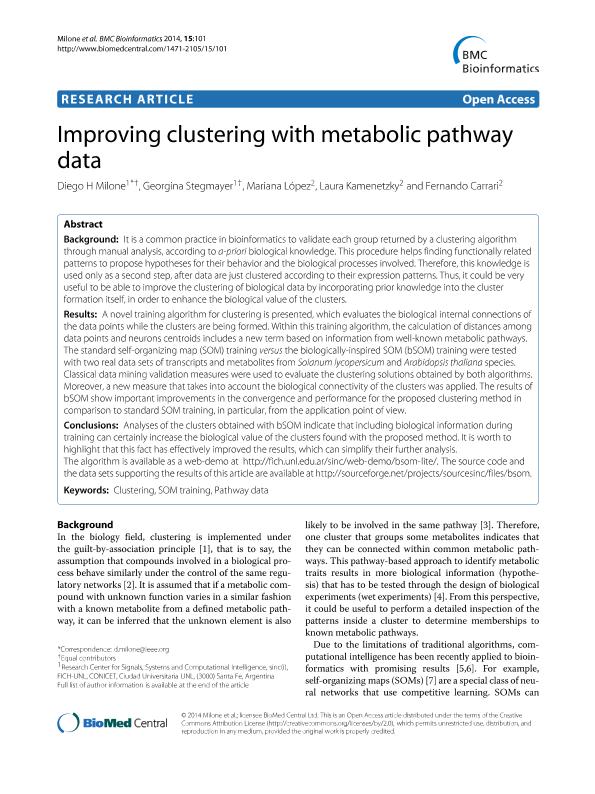Mostrar el registro sencillo del ítem
dc.contributor.author
Milone, Diego Humberto

dc.contributor.author
Stegmayer, Georgina

dc.contributor.author
Lopez, Mariana Gabriela

dc.contributor.author
Kamenetzky, Laura

dc.contributor.author
Carrari, Fernando Oscar

dc.date.available
2017-12-28T15:42:48Z
dc.date.issued
2014-04
dc.identifier.citation
Carrari, Fernando Oscar; Kamenetzky, Laura; Lopez, Mariana Gabriela; Stegmayer, Georgina; Milone, Diego Humberto; Improving clustering with metabolic pathway data; BioMed Central; Bmc Bioinformatics; 15; 101; 4-2014; 1-10
dc.identifier.issn
1471-2105
dc.identifier.uri
http://hdl.handle.net/11336/31795
dc.description.abstract
Background: It is a common practice in bioinformatics to validate each group returned by a clustering algorithm through manual analysis, according to a-priori biological knowledge. This procedure helps finding functionally related patterns to propose hypotheses for their behavior and the biological processes involved. Therefore, this knowledge is used only as a second step, after data are just clustered according to their expression patterns. Thus, it could be very useful to be able to improve the clustering of biological data by incorporating prior knowledge into the cluster formation itself, in order to enhance the biological value of the clusters.
Results: A novel training algorithm for clustering is presented, which evaluates the biological internal connections of the data points while the clusters are being formed. Within this training algorithm, the calculation of distances among data points and neurons centroids includes a new term based on information from well-known metabolic pathways. The standard self-organizing map (SOM) training versus the biologically-inspired SOM (bSOM) training were tested with two real data sets of transcripts and metabolites from Solanum lycopersicum and Arabidopsis thaliana species. Classical data mining validation measures were used to evaluate the clustering solutions obtained by both algorithms. Moreover, a new measure that takes into account the biological connectivity of the clusters was applied. The results of bSOM show important improvements in the convergence and performance for the proposed clustering method in comparison to standard SOM training, in particular, from the application point of view.
Conclusions: Analyses of the clusters obtained with bSOM indicate that including biological information during training can certainly increase the biological value of the clusters found with the proposed method. It is worth to highlight that this fact has effectively improved the results, which can simplify their further analysis.
dc.format
application/pdf
dc.language.iso
eng
dc.publisher
BioMed Central

dc.rights
info:eu-repo/semantics/openAccess
dc.rights.uri
https://creativecommons.org/licenses/by-nc-sa/2.5/ar/
dc.subject
Clustering
dc.subject
Som Training
dc.subject
Pathway Data
dc.subject.classification
Ciencias de la Computación

dc.subject.classification
Ciencias de la Computación e Información

dc.subject.classification
CIENCIAS NATURALES Y EXACTAS

dc.title
Improving clustering with metabolic pathway data
dc.type
info:eu-repo/semantics/article
dc.type
info:ar-repo/semantics/artículo
dc.type
info:eu-repo/semantics/publishedVersion
dc.date.updated
2017-12-11T16:43:50Z
dc.journal.volume
15
dc.journal.number
101
dc.journal.pagination
1-10
dc.journal.pais
Reino Unido

dc.journal.ciudad
Londres
dc.description.fil
Fil: Milone, Diego Humberto. Consejo Nacional de Investigaciones Científicas y Técnicas. Centro Científico Tecnológico Conicet - Santa Fe. Instituto de Investigación en Señales, Sistemas e Inteligencia Computacional. Universidad Nacional del Litoral. Facultad de Ingeniería y Ciencias Hídricas. Instituto de Investigación en Señales, Sistemas e Inteligencia Computacional; Argentina
dc.description.fil
Fil: Stegmayer, Georgina. Consejo Nacional de Investigaciones Científicas y Técnicas. Centro Científico Tecnológico Conicet - Santa Fe. Instituto de Investigación en Señales, Sistemas e Inteligencia Computacional. Universidad Nacional del Litoral. Facultad de Ingeniería y Ciencias Hídricas. Instituto de Investigación en Señales, Sistemas e Inteligencia Computacional; Argentina
dc.description.fil
Fil: Lopez, Mariana Gabriela. Instituto Nacional de Tecnología Agropecuaria. Centro de Investigación en Ciencias Veterinarias y Agronómicas. Instituto de Biotecnología; Argentina. Consejo Nacional de Investigaciones Científicas y Técnicas; Argentina
dc.description.fil
Fil: Kamenetzky, Laura. Consejo Nacional de Investigaciones Científicas y Técnicas; Argentina. Instituto Nacional de Tecnología Agropecuaria. Centro de Investigación en Ciencias Veterinarias y Agronómicas. Instituto de Biotecnología; Argentina
dc.description.fil
Fil: Carrari, Fernando Oscar. Consejo Nacional de Investigaciones Científicas y Técnicas; Argentina. Instituto Nacional de Tecnología Agropecuaria. Centro de Investigación en Ciencias Veterinarias y Agronómicas. Instituto de Biotecnología; Argentina
dc.journal.title
Bmc Bioinformatics

dc.relation.alternativeid
info:eu-repo/semantics/altIdentifier/url/https://bmcbioinformatics.biomedcentral.com/articles/10.1186/1471-2105-15-101
dc.relation.alternativeid
info:eu-repo/semantics/altIdentifier/doi/http://dx.doi.org/10.1186/1471-2105-15-101
Archivos asociados
